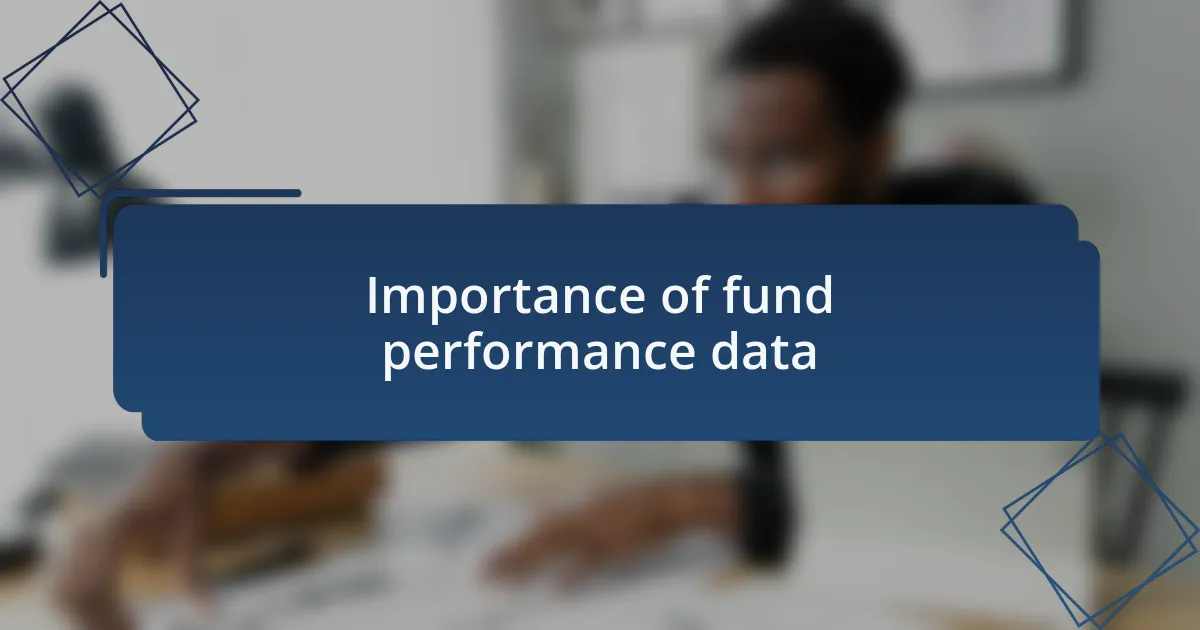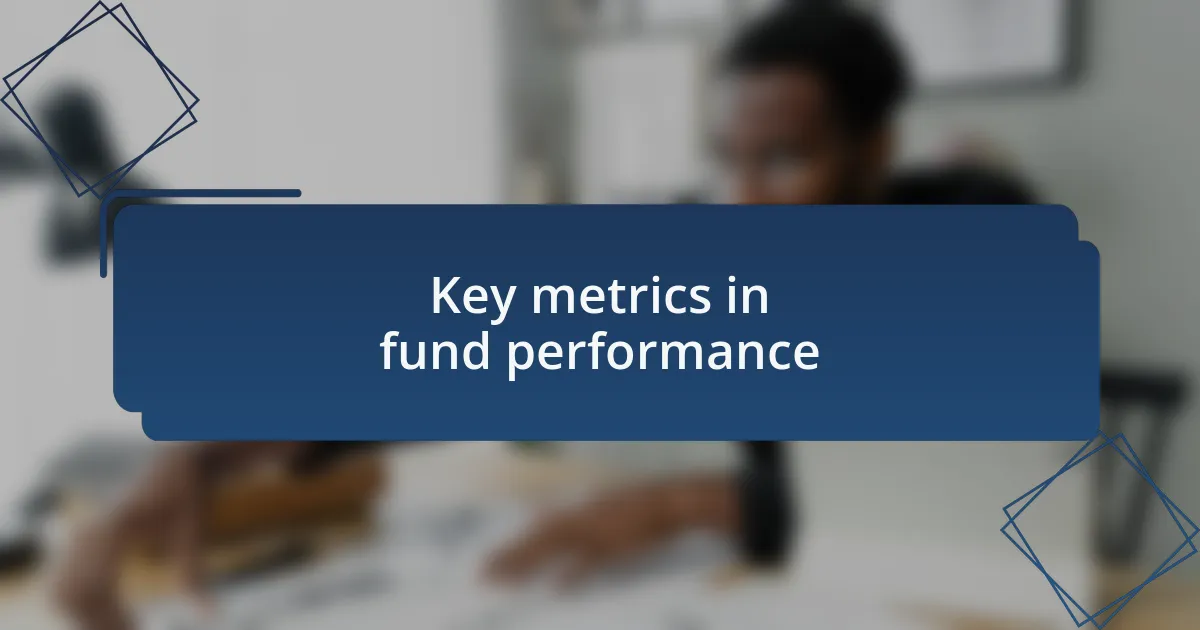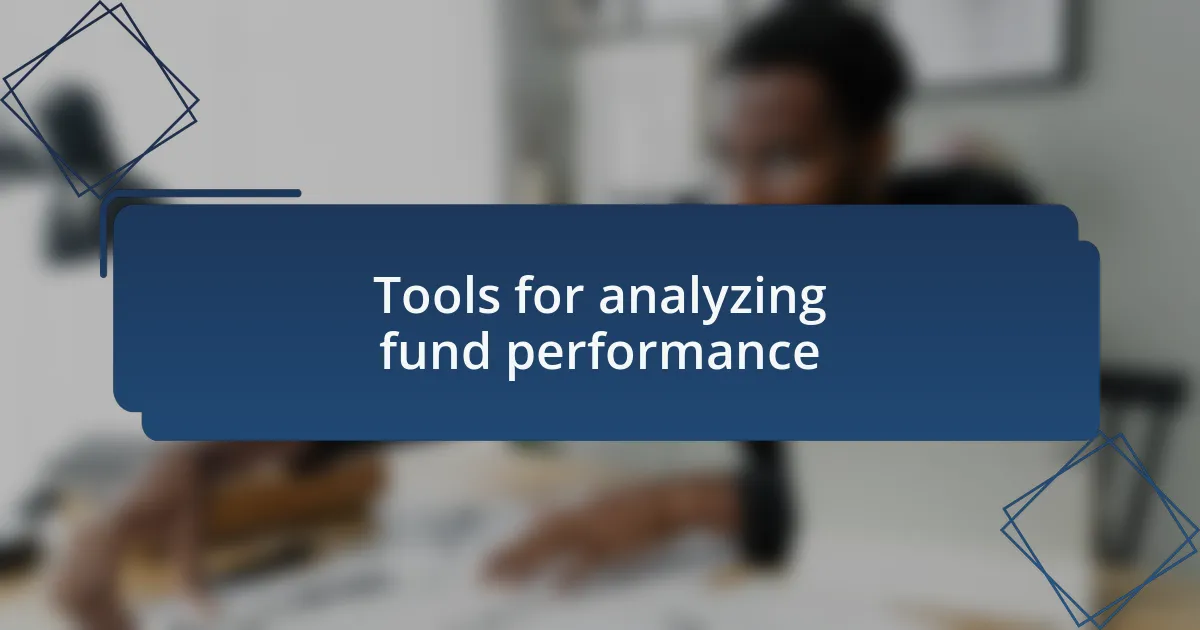Key takeaways:
- Eco-friendly finance merges financial profitability with sustainability, showcasing the potential for investments to support a greener future.
- Understanding fund performance metrics, such as expense ratios and Sharpe ratios, is crucial for making informed eco-friendly investment decisions.
- Utilizing tools like Morningstar and fund screeners can enhance the analysis of fund performance and help tailor investment choices to individual values.
- Challenges such as inconsistent data and bias between personal beliefs and analytical judgment require diligent analysis and simplification to ensure objective investment decisions.

Understanding eco-friendly finance
Eco-friendly finance, at its core, is about aligning financial profitability with sustainability. I remember the first time I realized that my investment choices directly impacted the environment. It was an eye-opener, urging me to think beyond traditional returns and consider how my money could support a greener future.
When I started exploring this concept, I often wondered, “Can my investments really make a difference?” The answer became clear as I dived into funds supporting renewable energy projects, sustainable agriculture, and green technologies. Each investment felt like a small victory against climate change, and I began to see how finance could be a powerful tool for positive change.
In my experience, the allure of eco-friendly finance lies not only in its ethical implications but also in its potential for innovation. Consider the growth of companies developing biodegradable materials or energy-efficient solutions. Investing in these areas can often yield attractive returns while fostering a sustainable economy. Doesn’t it feel good knowing that your financial choices can promote both your personal wealth and the health of our planet?

Importance of fund performance data
Understanding fund performance data is crucial for any investor, especially when venturing into eco-friendly finance. I recall my early days of investing, where it often felt like throwing darts at a board. Analyzing fund performance data provided the clarity I needed; it revealed which eco-friendly funds were genuinely making a positive impact, and which were falling short. It’s fascinating how a few key metrics can guide you toward investments that align with your values.
When I started looking closely at performance data, it became apparent that not all eco-friendly funds are created equal. I remember stumbling upon a fund that claimed to support green initiatives. However, deeper analysis showed lackluster returns compared to competitors focused on renewable resources. This discrepancy made me realize that informed decisions require more than just a fund’s green label—it demands transparency and scrutiny.
The journey through fund performance data has also transformed my investment strategy. By tracking returns over time, I’ve become more strategic, allowing me to pivot towards funds that are not only sustainable but lucrative. Have you ever felt that thrill of discovering a fund that exceeds your expectations? It’s a reminder that the right information can empower us to make choices that benefit both our wallets and the environment.

Key metrics in fund performance
When it comes to assessing fund performance, several key metrics stand out. For instance, analyzing the fund’s expense ratio can reveal how much you’ll be paying in fees versus the return on investment. I once underestimated how these fees could erode potential gains, leading to a sobering realization during tax time. Have you ever calculated what a small fee can mean over the long haul? It made me rethink my approach entirely.
Another important aspect is the fund’s Sharpe ratio, which measures risk-adjusted returns. I remember evaluating this metric for a clean energy fund and feeling impressed by its high score; it suggested that the returns were solid relative to the level of risk taken. This discovery helped me appreciate that it’s not just about chasing returns but understanding the risks involved as well.
Finally, I can’t stress enough the value of the fund’s historical performance compared to its benchmark. Seeing how a fund stacks up against an industry standard can illuminate its true potential. I vividly recall a moment when I realized a fund, which seemed great on the surface, was trailing significantly behind its benchmark. This experience emphasized the need to dig deeper; it’s about finding funds that truly stand out in a crowded market. What metrics are you most curious about? The answers could direct you toward more informed investment choices.

Tools for analyzing fund performance
When analyzing fund performance, several tools can enhance your understanding. One of my favorites is Morningstar, which offers easy access to an extensive database of funds, complete with ratings and in-depth analyses. The first time I explored its features, I felt like I had a financial advisor at my fingertips. Have you ever found a tool that just clicked for you and made the numbers come alive?
Another invaluable resource is a fund screener, like those on Yahoo Finance or Google Finance. These tools allow you to filter funds based on various criteria, such as performance history or fees. I remember using a screener to narrow down eco-friendly funds that met my sustainability criteria while still priming my portfolio for growth. It felt empowering to have such customization at my disposal, honing in on what truly mattered to me.
Lastly, utilizing Excel or Google Sheets can be a game changer for analyzing fund performance. I’ve created my own templates for tracking personal investments, visualizing trends, and assessing the impact of fees over time. There’s something deeply satisfying about manipulating your own data, as it personalizes the investment journey. Have you tried building your own spreadsheet? It’s an incredible way to feel more in control of your financial future.

Challenges I faced during analysis
Analyzing fund performance came with its fair share of challenges. One significant hurdle I faced was the inconsistent availability and quality of data across different platforms. I remember spending hours trying to reconcile figures from various sources, only to find discrepancies that left me second-guessing my findings. Have you ever felt like you were chasing ghosts in a sea of numbers?
Another difficulty was interpreting complex financial metrics. At times, terms like “alpha” and “beta” felt like a different language, one I was determined to decode. I vividly recall a moment grappling with a fund’s performance and feeling overwhelmed, wishing I had a simplified guide by my side. How can we confidently analyze funds if we can’t decode the lingo?
Lastly, there’s the challenge of bias when picking eco-friendly funds. I found myself often swayed by personal beliefs, which occasionally clouded my judgment. Striking the right balance between sustainability and returns demanded a critical eye and constant reassessment of my choices. Have you encountered moments where your values and analytical mind clashed? It’s a constant dance, balancing passion with pragmatism.

Lessons learned from my experience
As I navigated through the maze of fund performance data, one crucial lesson I learned was the importance of building a reliable data foundation. I remember one particular instance where I double-checked my sources, only to uncover a significant error that changed the entire narrative of my analysis. That experience underscored the need for diligence; having trustworthy data wasn’t just beneficial—it was essential.
Another point of realization for me was the value of simplifying complex information. During my analysis, I often felt like I was drowning in jargon that obscured the real story behind the numbers. It was in these moments of frustration that I realized the benefit of using visual aids and plain language; after all, if I found it challenging, what about others trying to interpret the same data?
Moreover, I came to appreciate the interplay between personal values and analytical judgment. There were times when I had to take a step back and assess whether my eco-friendly inclinations were distorting my interpretation of the data. It prompts a valid question: how do we ensure that our passions don’t blind us to objective analysis? Finding that equilibrium became a pivotal part of my journey in mastering fund performance data.